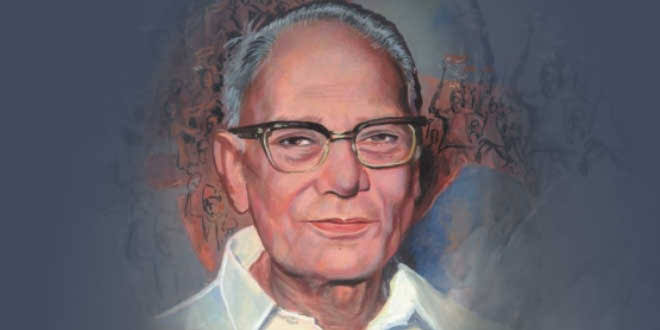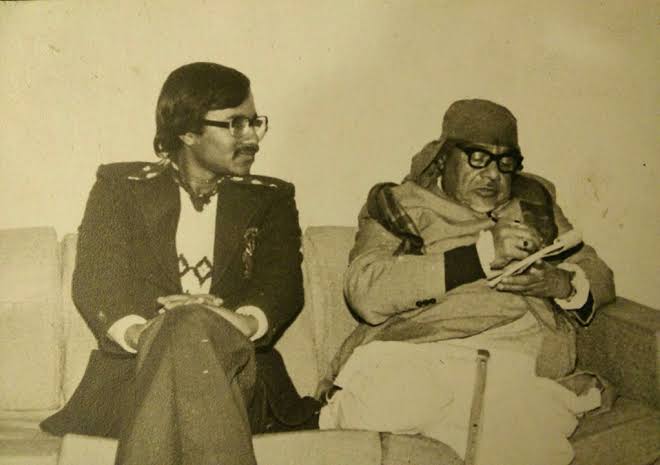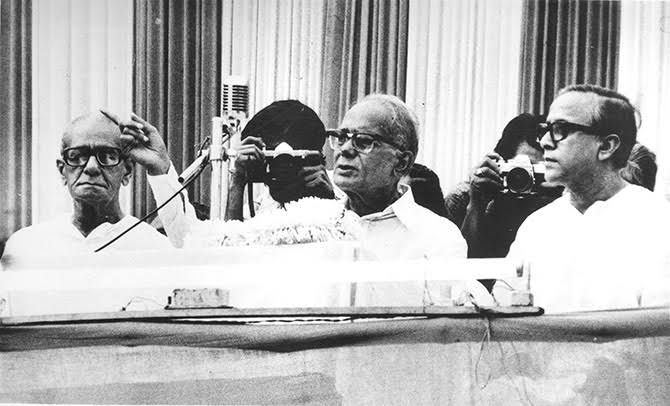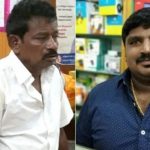Jayaprakash Narayan, a Gandhian and Sarvodaya leader, lived in Bihar. He had grown old and decided to spend the rest of his life involved in constructive activities in a limited area in Bihar. (Express archive: R K Sharma)
It began sometime during November-December 1973 in Gujarat. Due to inflation, an engineering college raised the mess bill for hostellers. There were strong protests. Other colleges in the state also raised the mess bills on the same account. Protests became widespread and grew strong to turn into a movement. Corruption was held responsible for inflation. It became a movement against inflation and corruption. The pinch of inflation and corruption was not confined to students alone, the movement became a public movement. Who was to be held responsible for the problems? Obviously, the government. The movement turned against the state government and the chief minister. It was termed as Navnirman Andolan.
The pinch of inflation and corruption was not confined to Gujarat. By February 1974, students in Bihar rose to action. There, too, the state government and chief minister were held responsible. In March, the movement started in Bihar. In order to curb it, the government used force. This only added fuel to the fire. Both in Gujarat and Bihar, it was students leading the movement. Inflation and corruption were not confined to the two states. The movement started spreading to other parts of the country, though Bihar became the epicentre.
Jayaprakash Narayan, a Gandhian and a Sarvodaya leader, lived in Bihar. He had grown old and had decided to spend the rest of his life involved in constructive activities in a limited area in Bihar. The student leaders of Bihar knew the worth of both — the issues being raised and JP. They knew that if JP came forward to bless them, the movement would gain respectability. And JP did bless them.
Once JP did that, the state government went berserk. JP was lathicharged when he led a demonstration in Patna. But JP was a mature and seasoned statesman. He ensured non-violent methods of protest and took the movement out of Bihar to make it a national movement. It did not remain confined to students. Four non-congress non-communist political parties (Bharatiya Jan Sangh, Congress O, Socialist Party and Bharatiya Lok Dal) became active in the movement. And the JP movement was born.
As the movement started picking up, the central government and then Prime Minister Indira Gandhi were held responsible for the corruption and inflation. But, JP did not confine himself to these two issues. He pointed at the other malaises in public life and gave a call for total revolution. He called upon the central government to address the issues.

From March 1974 to June 1975, the movement went through different phases and a lot of political activities took place. All said and done, it was a national movement against the central government in general, and the PM in particular. In her own way, Indira Gandhi tried to defuse the situation, but she failed. She had been in power for nearly four years and the movement leaders asked for her resignation.
The flashpoint came on June 12, 1975, when two major developments took place. Earlier in March, the movement had achieved a partial victory when the chief minister of Gujarat resigned, paving way for fresh assembly elections. On June 12, his party lost in the election which provided a fillip for the national movement. Simultaneously, on June 12, Indira Gandhi lost an election petition against her wherein she had been charged with malpractices in her election to Lok Sabha in 1971. For the movement, the demand for her resignation became logical. As she had lost in the high court, she preferred to go to Supreme Court and stuck to her post. Though a minor one, Indira Gandhi got yet another jolt on June 12 — the death of a political aide, D P Dhar.
The battle entered its crucial phase. Forces on both sides strengthened themselves. Indira Gandhi decided to continue as PM as the Supreme Court had granted her partial stay so far as her Lok Sabha seat was concerned. It facilitated her continuation as PM. JP, on the other hand, called for a rally in Ram Lila Maidan in Delhi on June 25 to announce his future course of action.
It was a massive rally. A call was given for a satyagraha to commence from June 29. JP asked the police and defence forces not to obey illegal orders from Indira Gandhi. Though it was a simple statement it was used against him for alleging that he was calling upon the police and defence forces to revolt against the government.

On the same day, at midnight, internal emergency declared. In fact, the ruling party had been considering the idea since the beginning of the year. Two things were done immediately — several eminent leaders were arrested and censorship was imposed on the media on that night itself. In the days after, the media was not free to report. Anything that was to be published had to be cleared by the censor authorities. What it implied was that nothing against the government would go in print. Those who dared to disobey were punished in one form or another.
The number of persons who were arrested kept swelling day by day. People who belonged to parties and organisations which were supporting the movement were arrested. Three types of arrests were made. The most stringent were made under the Maintenance of Internal Security Act (MISA), which allowed the government to detain anyone whom it considered necessary. As the title of the law suggests, the arrest was made for the maintenance of internal security. It was preventive detention. The duration of arrest was also in the hands of the government.
The second type of arrests were made under the Defence of India Rules (DIR). Such an arrest could be made when someone was found to be involved in activities threatening the law and order of the country. An arrest was to be made for a real act endangering law and order, and the arrested person had to be prosecuted for the offence in a court of law. A large scale mockery of the law was made at the instance of Congress leaders. People were identified for arrest, false charges were levelled against them and they were put behind the bars.
Then there was the third category of arrests — the mildest one. Some minor charges would be levelled and persons would be arrested. This scene lingered on for months. Those opposed to the Emergency developed their own ways of opposing it. Underground activities and literature, and overground satyagraha in opposition to the Emergency were the two tools adopted.
As JP had been arrested on the first night itself, the leadership of the movement came in the hands of Nanaji Deshmukh, the veteran leader of the Bharatiya Jana Sangh (the earlier incarnation of BJP). In late August 1975, Nanaji, who had been successful in avoiding arrest till then, was nabbed. Thereafter, the leadership fell in the hands of Dattopant Thengdi — a veteran trade union leader. Beginning in October 1975, a nationwide satyagraha was launched. Around 1,00,000 people courted arrest.

The Emergency and the battle against it went on till the end of 1976. Various efforts were also made to diffuse the situation but to no result. As a person, Indira Gandhi was a strong-headed ruler. Democracy was nowhere to be experienced in the country. The Lok Sabha’s period had been extended earlier by one year to delay the election which became due in early 1976. Then came January 1977. The Emergency was relaxed and Lok Sabha elections were held in March 1977. Much to her astonishment, not only her party was defeated, but Indira Gandhi and her son Sanjay Gandhi could not get elected to Lok Sabha.
It’s important to know why Indira Gandhi opted to impose the Emergency. She had already ruled the country for over four years and to fulfil the demand of democracy she could have ordered fresh Lok Sabha elections. But she was not a “democrat”. She was an autocrat whom political developments had catapulted to the top post in the country. Her authoritarian traits started unfolding when she split her party in 1969 and captured the top position in the party and the government. To her advantage, the Opposition parties had miserably failed in challenging her in the 1971 Lok Sabha election, which she won with a thumping majority. Another development at the end of 1971 — the war with Pakistan and the creation of Bangladesh — further increased her popularity. She would accept no challenge to her supremacy. She preferred confrontationist politics.
A legitimate question can be asked: Why did she choose to go in for elections in 1977? There were several reasons. Though she was an autocrat, she was not an absolute dictator. Nor was the governmental machinery suitable for dictatorship. She had grown up in a democratic country, which had seen five Lok Sabha elections, the last one going in her favour in a big way, and the sixth had become overdue. It is also said that she was fairly confident of winning the election.
It is also pertinent to note that a certain socio-political force played a key role in the developments before and during the Emergency. It was the Sangh Parivar, which has been denied its due in the historical evaluation of events.
The Gujarat movement in beginning was a spontaneous one, but it survived because of the major role played by the ABVP. The Bihar movement was a creation of ABVP. It was leaders of the ABVP and the RSS — Ram Bahadur Rai and K N Govindacharaya — who roped in JP. In the JP movement, the ABVP, Bharatiya Jana Sangh (which was biggest amongst the four parties supporting the movement) and the rest of the Sangh Parivar played a leading role. During the Emergency, it was Deshmukh and Thengdi (founder of the Bharatiya Mazdoor Sangh, a trade union affiliate of the Sangh Parivar) who led the underground movement. In the satyagraha, the largest contributor was the RSS and the Parivar.
–Written by Raj Kumar Bhatia
The writer was National General Secretary of ABVP between 1970-74 and was detained under MISA for almost the entire period of the Emergency
( The writer is also a Human Rights Activists and Senior Member of HRDI )
Link – https://indianexpress.com/article/opinion/the-unsung-heroes-of-the-emergency-6474414/
The Article was published in Indian Express on June 24, 2020




















